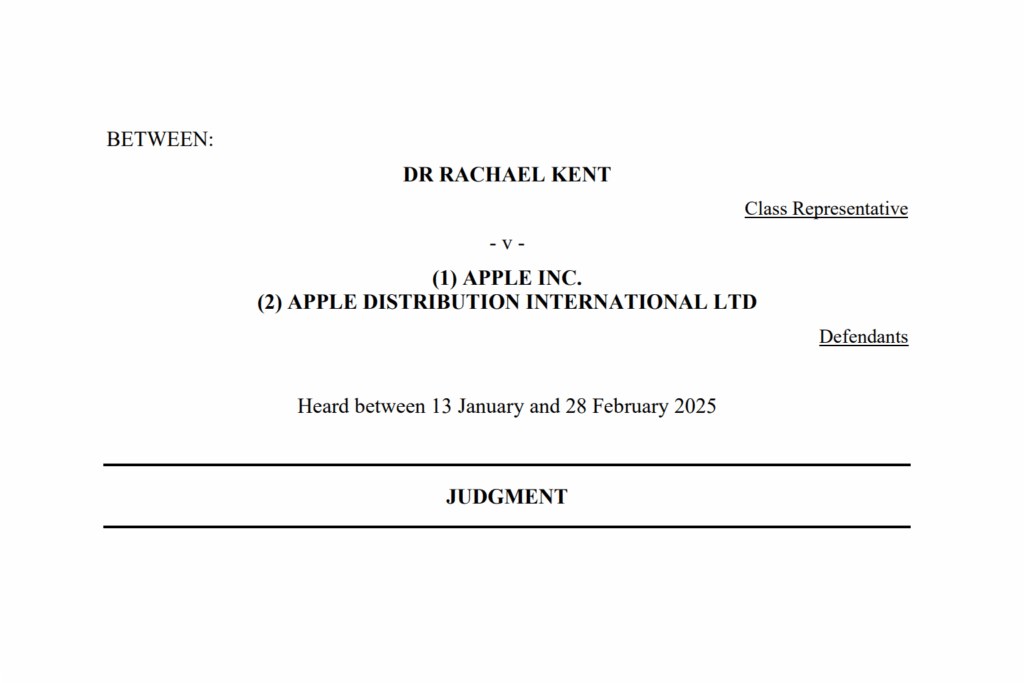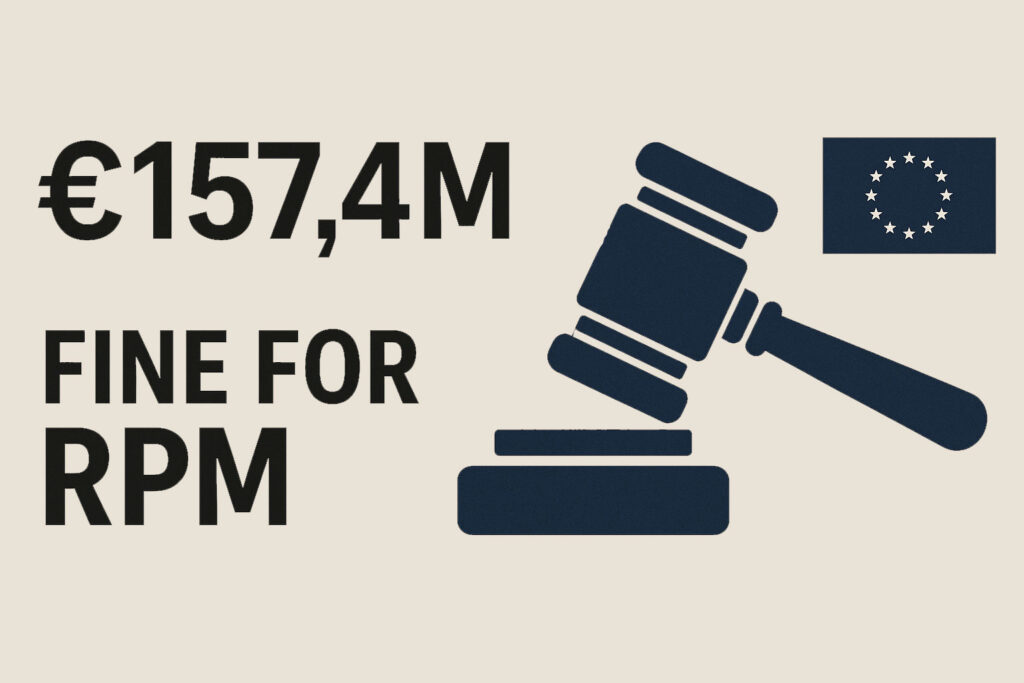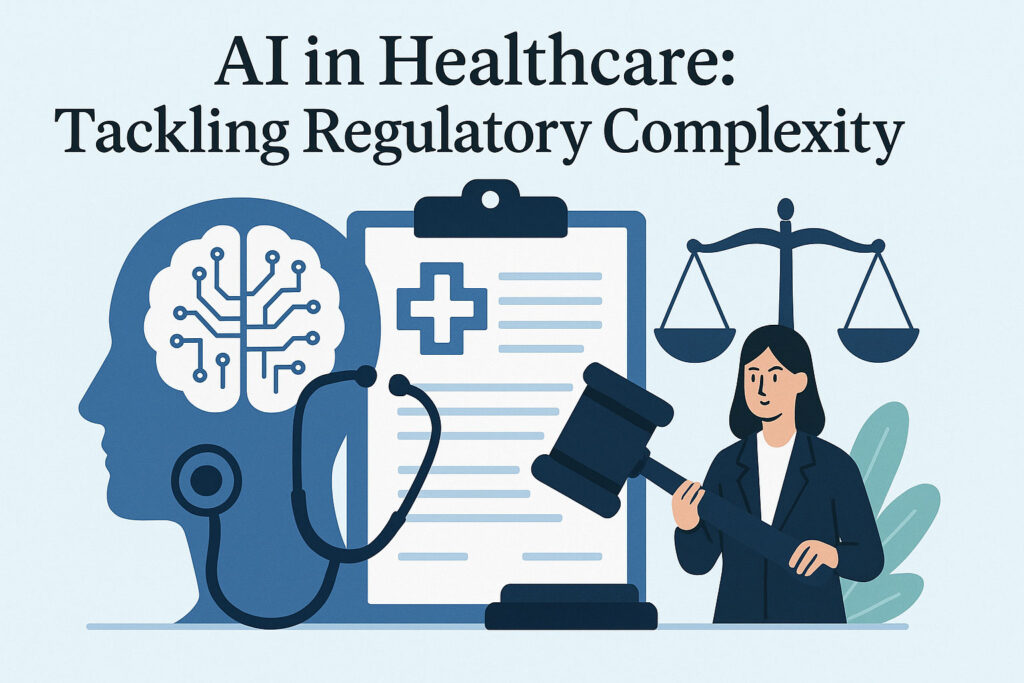On 23 October 2025 the Competition Appeal Tribunal (the “Tribunal”) issued a full, unanimous judgment in Dr Rachael Kent v Apple Inc & Apple Distribution International Ltd finding that Apple abused a dominant position in two narrowly defined UK markets, namely the iOS app distribution services and iOS in-app payment services markets, in the time between the 1st of October 2015 and the 15th of November 2024. The Tribunal held that Apple’s contractual and technical restrictions foreclosed competition, including by tying its in-app payment services to App Store distribution. It further held that the 30% commission was excessive and unfair and that Apple’s justifications such as objectively necessary security or privacy efficiencies and operation-efficiency arguments failed on the evidence. For quantum the CAT adopted counterfactual commission benchmarks of 17.5% for distribution and 10% for in-app payments and applied a 50% incidence assumption for pass-through to users. Consequential hearings on precise damages and costs have been ordered.
Importance of this decision
This is a landmark decision in UK competition law for three interlocking reasons:
- A leading platform operator has been found liable on both exclusionary and exploitative theories in closely defined platform aftermarkets, which is a blueprint for how courts apply classic abuse concepts to modern platforms.
- The Tribunal applied established excessive pricing principles to platform commissions, producing concrete counterfactual benchmarks (17.5% and 10%) and a pass-through assumption (50%) to model aggregate consumer loss and thus giving market participants usable planning numbers for litigation risk.
- The judgment clarifies evidential expectations for ‘security and integrity justifications’. General assertions of integrated security are insufficient and firms must show narrow, proportionate linkages between specific restrictions and incremental benefits.
Taken together, the judgment raises both litigation and compliance stakes for platform owners that combine device control, exclusive distribution channels, and bundled payment services.
Quick refresher: the UK competition legal framework
The Tribunal structured its legal analysis in the familiar four-step progression:
- market definition,
- finding dominance,
- establishing an abuse (exclusionary and exploitative), and
- considering defences and remedies/quantum.
The claim was brought under section 18 of the Competition Act 1998 (Chapter II) and for the period before 31st of December 2020 under the EU competition law regime in Article 102 TFEU since both regimes were relevant to the claim period.
The key points of law and principle the CAT used:
- Market definition: remains fact intensive and uses the hypothetical monopolist / SSNIP test logic while guarding against the Cellophane fallacy. The Tribunal emphasised careful assessment of practical substitutability and real-world constraints such as technical, contractual and behavioural.
- Dominance: is a question of economic strength in the relevant market and a narrow market definition can lead to finding very large market power if alternatives are not close substitutes.
- Abuse: classic exclusionary categories such as exclusive dealing, tying and foreclosure as well as exploitative abuses such as excessive pricing or unfair terms do apply to digital platforms but must be proven with an effects-based analysis.
- Defences: objective necessity and efficiencies defences are available to a dominant firm but require specific, cumulative proof, such as necessity, proportionality, quantifiable efficiencies that outweigh foreclosure.
- Quantum: where counterfactual modelling is inherently uncertain, courts appear to adopt a pragmatic approach: do the best the evidence allows and avoid letting the absence of perfect precision defeat compensation.
This case operationalises these principles in the platform context. The CAT’s reasoning is therefore a useful practical template for counsel and compliance teams.
Short Case Facts
The claim was brought as a collective action on behalf of about 36 million class members, representing UK iOS device users who made paid app purchases or in-app purchases in the time between the 1st of October 2015 and the 15th of November 2024.
It advanced two principal abuse theories: (a) exclusionary abuse, because Apple’s contractual and technical restrictions created foreclosure by requiring distribution of native iOS apps via the App Store and mandating use of Apple’s in-app payment systems for in-app sales and (b) exploitative abuse, because Apple charged an excessive and unfair 30% commission which inflated consumer prices.
Market Definition and Dominance
Narrow and fact driven markets
The CAT rejected broad system-level markets and instead defined two aftermarkets:
- The iOS app distribution services market, which is a two-sided market matching iOS developers with iOS device users for native apps, as such being an aftermarket to the device market, and
- The iOS in-app payment services market, which is a single-sided aftermarket enabling iOS device users to transact in-app with developers.
Why these narrow market definitions? The CAT carefully tested substitution claims (web apps, cross-device purchases, Android/Google Play, third-party marketplaces) and concluded that those alternatives were not sufficiently close in practice to constrain the App Store. This involved attention to both contractual barriers and technical limitations experienced by developers and consumers.
Dominance follows market definition
Because the markets were narrowly drawn and Apple’s App Store was the exclusive practical channel for distribution and for in-app payments, the CAT concluded that Apple held almost absolute market power in both markets in the relevant time period. The finding of dominance was supported by Apple’s de facto 100% market share position in the relevant channels and the high contractual barriers Apple had created according to the CAT.
The Exclusionary Abuses
Exclusive dealing / foreclosure
The Class Representative’s central factual case was that Apple’s Developer Program Licence Agreement (DPLA), App Review Guidelines and technical controls prevented developers from distributing native iOS apps except through the App Store and prevented the use of alternative in-app payment systems for most digital transactions. The Competition Appeal Tribunal agreed that Apple’s contractual and technical restrictions foreclosed competition in the two defined markets and therefore infringed CA 1998 Chapter II / Article 102 TFEU.
Notably, the CAT rejected Apple’s Magill/IMS-style IP reservation argument. Apple contended that aspects of its tools and technology were its property and that restricting distribution or use flowed from legitimate IP rights. The Tribunal held that Apple had licensed the tools and technology sufficiently widely and had not reserved exclusive use in a way that would invoke the narrow Magill access doctrine. Instead, the restrictions operated as independent market-foreclosing measures.
Tying
The CAT applied the standard four-part tying test:
- Are there separate products,
- is there dominance in the tying product,
- is there no customer choice to acquire the tying product without the tied product, and
- are there foreclosure effects.
It found that Apple tied its in-app payment (the tied product) to App Store distribution (the tying product), because developers distributing via the App Store were generally unable to use third-party in-app payment options, and that the tying foreclosed competition in the payments aftermarket.
Key takeaways for practitioners and compliance teams: contractual and technical measures that make use of in-platform payments mandatory, or that severely restrict alternative routing, create tying exposure where the operator is dominant in one relevant market. The CAT looked at function and effect and not the packaging.
The Exploitative Abuses
After the Tribunal concluded that Apple’s contractual and technical restrictions gave rise to exclusionary abuses (foreclosure and tying), it turned to the separate but related allegation of exploitative conduct. This included Apple’s 30% commission and associated fee structure amounting to excessive and unfair pricing in the relevant aftermarkets.
The CAT treated this as a distinct type of abuse requiring its own two-stage analysis:
- Identify an appropriate benchmark or counterfactual “non-abusive” price, and then
- decide whether the charged price was unfair in relation to that benchmark, to costs/profits, and to credible comparators.
The CAT’s methodology
The Tribunal applied the two-limb approach to exploitative pricing claims. First, it sought an economically sensible counterfactual price, which is a fee that would have prevailed in a competitive or non-abusive market purged of the unlawful restraints. Given the difficulty of producing an exact counterfactual over a multi-year claim period, the CAT adopted a pragmatic, evidence-led approach of using the best available comparator evidence, expert modelling and market-structure analysis to arrive at reasonable non-abusive benchmarks.
Second, the Tribunal tested fairness by reference to profit margins, cost allocation, comparator platforms and the persistence of returns. High, persistent margins on a core gatekeeper service, when unsupported by transparent cost justifications or offsetting consumer benefits, reinforced the conclusion that the fees were exploitative.
The adopted counterfactual benchmarks
On the basis of the evidence from economic expert reports, comparator platform analysis and consideration of the relevant service components, the CAT settled on the following practical non-abusive benchmarks for damages purposes:
- iOS app distribution services (distribution commission): 17.5%.
- iOS in-app payment services (payments commission): 10%.
Those levels were selected as realistic competitive counterfactuals that reflected plausible market outcomes in a world without Apple’s exclusionary restrictions. The Competition Appeal Tribunal emphasised that these figures were context-specific working assumptions for the purpose of quantum rather than a universal rule for all platforms or jurisdictions.
Fairness, costs and profit evidence
To assess unfairness, the CAT reviewed how Apple allocated costs between i.e.program-level fees, platform tools and the commission that purportedly remunerated distribution and payments. It also examined profitability metrics and comparator prices. Where Apple’s allocations and justifications did not persuasively explain the scale of returns or the persistence of the fee premium, the Competition Appeal Tribunal treated it as corroborating evidence of exploitative pricing. Nonetheless, the Tribunal reiterated that exploitative findings must be anchored in robust economic reasoning rather than mere suspicion of high prices.
Pass-through (incidence) and aggregate effect
For damages the Competition Appeal Tribunal needed a credible assumption about incidence, which is the proportion of the overcharge borne by end users. Facing competing expert views, the Tribunal adopted a pragmatic mid-range figure of 50% incidence. That assumption meant that half of the difference between Apple’s actual commission and the counterfactual benchmarks would be treated as having been passed through to consumers and therefore recoverable on an aggregate basis. The Tribunal noted the inherent uncertainty in pass-through modelling and justified its approach as a reasonable compromise in the interests of compensation.
Key nuances and caveats
A few important qualifications on the Tribunal’s exploitative analysis:
- Fact specificity: the 17.5% and 10% figures are grounded in the particular evidence of this case and do not present a rigid cap on what a platform can lawfully charge.
- CAT pragmatism: the Tribunal recognised modelling uncertainties and explicitly used a pragmatic approach to avoid letting the lack of perfect precision prevent redress. That pragmatic posture means different evidence sets in other cases could produce materially different counterfactuals.
- Complementary role of profits evidence: profitability did not, by itself, determine unfairness but was an important corroborative element when combined with benchmark and comparator evidence.
Key takeaways for practitioners and compliance teams:Platform owners should keep transparent and defensible cost-allocation records linking fees to concrete services i.e.fraud prevention, billing, SDKs, distribution. Where a fee materially exceeds plausible comparators, be prepared to explain why and maybe argue for service quality, reach, lower fraud or bundled value.
Pricing strategy teams must treat persistent supra-competitive margins as litigation risk factors and should stress test fee schedules against plausible counterfactuals and comparator platforms. The Tribunal’s concrete benchmarks provide useful stress test scenarios for internal provisioning.
Regulatory Consequences and Cross-jurisdictional Interplay
Though this case was a private collective action, the CAT engaged extensively with regulatory materials (the CMA’s MEM Study, various national authority work, and earlier EU Commission decisions). This engagement means the judgment will be cited in regulatory files and in foreign litigation and will likely influence compliance expectations under ex-ante regimes such as the European DMA obligations and national implementations. Firms should therefore treat public enforcement and private litigation as co-equal risks requiring harmonised responses.
Conclusion
Dr Rachael Kent v Apple is a wake-up call. The Competition Appeal Tribunal made clear that modern competition law applies effectively to platform gatekeepers in the UK. Contractual wording, technical design and pricing choices are all scrutinised for their competitive effect and must be defensible with detailed evidence. The judgment does not outlaw integration as such, but it raises the evidential bar for blanket prohibitions and for unsubstantiated fee structures.
For platform owners the takeaways are clear: prove necessity, document proportionality, be transparent about prices and costs, and design where possible for choice. For developers and marketplace entrants the ruling is an important vindication that structural barriers to reaching installed user bases can be unlawful and that competition can be restored by litigation or regulatory pressure.




